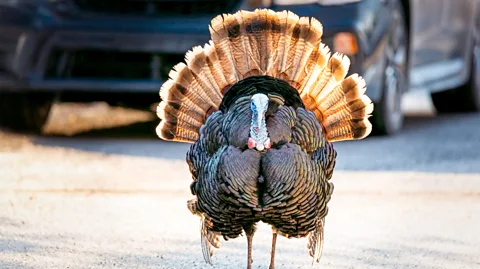Fearless wild turkeys are roaming US cities – and it’s a rare conservation success

 Getty Images
Getty ImagesAfter almost disappearing, a large bird with a feathery swagger has bounced back in the US – and numbers are rising fast in some states.
A few years ago, I lived in Cambridge, Massachusetts, where large wild birds roamed the streets. Around the same height as my daughter, they feared no man, nonchalantly wandering through heavy traffic, into people's gardens, and across the campus of Harvard University.
It's the same story elsewhere. A friend of mine – the journalist Bethany Brookshire – lives in Washington DC, and wrote last year about how the birds had been terrorising citizens there: some people had even been hospitalised. Another friend, who lives in Des Moines, told me the creatures had blocked traffic in front of a local school recently.
The bird in question is the wild turkey (Meleagris gallopavo), a species once all but eradicated in the US. And their return – despite all the pecking and bothering of passers-by – is something to be celebrated. "The restoration of wild turkeys is one of the greatest North American conservation stories," writes Michael Chamberlain of the University of Georgia and colleagues in a recent US turkey "census".
 Getty Images
Getty ImagesWhen European settlers first came to the US, turkeys were abundant, but overhunting and deforestation led to steep declines. It was only when conservationists managed to capture and redistribute the birds in the 20th Century – sometimes using "cannon nets" – that the birds' fortunes began to turn around.
According to Chamberlain and colleagues, the states with the greatest numbers of the birds – in the hundreds of thousands – are Alabama, California, Texas, Wisconsin and Kentucky. The picture isn't so good everwhere. In Oklahoma, for example, researchers say wild turkey numbers have steadily declined over the past 15 years while the turkey population in Kansas fell by 60% between 2008 and 2021. However, New England has experienced significant rises since 2014. In Massachusetts, numbers rose by 30%, and in Vermont and Maine, the estimated rise is as high as 40-50%.
You may also like:
Of course, not everyone who encounters a turkey on a city street agrees that the birds' return is a cause for celebration. They are, after all, quite a bit heftier and more aggressive than pigeons.
As Brookshire wrote of the turkeys causing havoc in Washington DC, many people were surprised by their ferocity and speed. "It's not something that I would expect to do at all, having to defend myself against a wild animal in DC," one cyclist told her. Another pointed out that the turkeys could run faster than they could. Turkeys can reach speeds of up to 15mph (25km/h).
However, as with other rewilding efforts after steep declines: learning to live alongside nature, in beak and claw, is part of the bargain.
--
If you liked this story, sign up for The Essential List newsletter – a handpicked selection of features, videos and can't-miss news delivered to your inbox every Friday.
